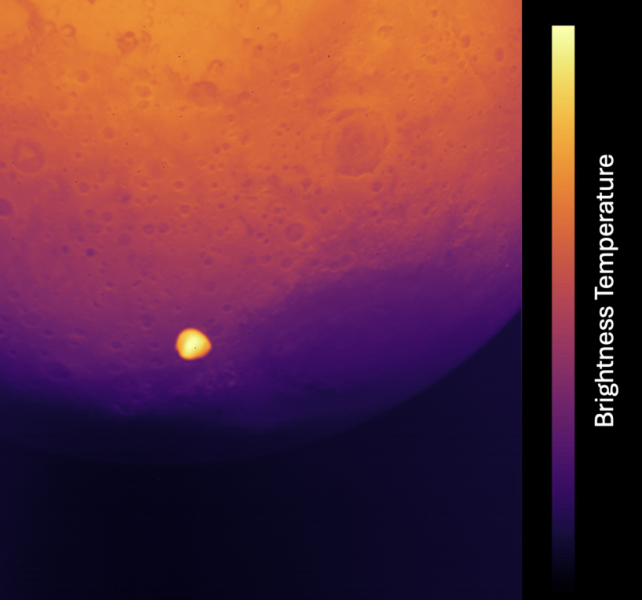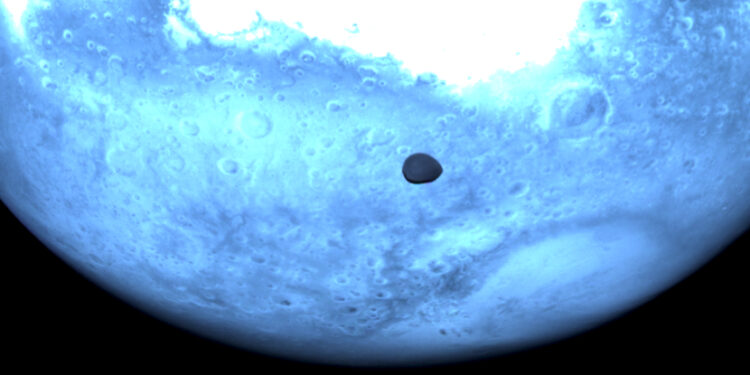A European spacecraft on a groundbreaking mission to study the aftermath of an asteroid collision recently captured rare images of Mars’ enigmatic moon Deimos, according to the European Space Agency (ESA). HERA, part of Europe’s planetary defense initiative, is designed to analyze the impact of NASA’s Double Asteroid Redirection Test (DART), which deliberately crashed into an asteroid in 2022. This historic experiment was the first real-world test of Earth’s ability to deflect potentially hazardous space rocks. However, HERA won’t reach its target—Dimorphos, a small asteroid orbiting the larger Didymos—until late 2026.
To optimize its trajectory and conserve fuel, HERA executed a gravitational assist maneuver around Mars on Wednesday. This maneuver altered the spacecraft’s path while also providing a unique opportunity to conduct scientific observations.
A Close Encounter with Mars and Deimos
During its brief flyby, HERA came within 5,600 kilometers of Mars’ surface, traveling at an astonishing 33,480 kilometers per hour. The spacecraft took full advantage of this close pass, testing its onboard instruments and capturing nearly 600 images, including exceptionally detailed shots of Deimos.
At just 12.5 kilometers in diameter, Deimos is the smaller and lesser-known of Mars’ two moons. Scientists are still debating whether Deimos and its companion Phobos are captured asteroids or remnants of a massive collision that took place on Mars long ago.
Marcel Popescu of the Astronomical Institute of the Romanian Academy emphasized that these new images contribute to ongoing research into the moon’s origins, adding “another piece of the puzzle” in understanding the Martian system.
HERA’s advanced imaging systems, including its “HyperScout” and infrared sensors, have the ability to detect wavelengths beyond human vision. This capability explains why Mars appears blue in some of the images rather than its usual reddish hue.
Revealed: the first images from @ESA‘s #HeraMission gravity-assist flyby of Mars! https://t.co/tG8hizuw9W pic.twitter.com/2qJEKwpb1W
— ESA Technology (@ESA_Tech) March 13, 2025
Preparing for the Next Phase of the Mission
With its Martian flyby complete, HERA is now focused on reaching Dimorphos, where it will conduct an in-depth analysis of the effects of NASA’s DART impact. In 2022, the DART spacecraft successfully altered Dimorphos’ orbit around Didymos by 33 minutes. Though this asteroid posed no risk to Earth, the experiment provided valuable insight into whether kinetic impactors could be used as a planetary defense strategy.

ESA is among several space agencies ramping up efforts to identify and track potentially hazardous asteroids. Earlier this year, a newly detected asteroid briefly caused concern when calculations suggested it had a small but real chance of hitting Earth in 2032. However, follow-up observations significantly lowered the risk.
Richard Moissl, head of ESA’s planetary defense office, noted that as telescopes improve, “we will discover asteroids at a higher rate,” making early detection and monitoring more effective.
In addition to HERA, ESA is developing another planetary defense mission to study Apophis, a 350-meter-wide asteroid that will make an extremely close pass by Earth on April 13, 2029. This flyby presents an unprecedented opportunity to study a near-Earth asteroid in detail and refine planetary defense strategies for the future.











